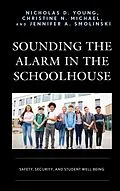Sounding the Alarm in the Schoolhouse: Safety, Security, and Student Well-Being was written as a resource guide for educational and mental health professionals and policymakers, as well as families and communities seeking to develop programming to reduce school violence and promote safe, engaging, and effective schools. This book explores the growing crisis in school safety and security through the lens of the roles that mental health and student and community well-being play in creating environments that are resistant to violent and antisocial behavior. The book gives practical information and research on school, classroom or community applications, the latest trends and issues in the field, and best practices for promoting student health and well-being. It also covers violence prevention measures and protocols to follow in crisis intervention situations. Issues of culture, gender and society are specifically addressed.
Autorentext
Dr. Nicholas D. Young has worked in diverse educational roles for more than 30 years, serving as a principal, special education director, graduate professor, graduate program director, graduate dean, and longtime superintendent of schools. He was named the Massachusetts Superintendent of the Year; and he completed a distinguished Fulbright program focused on the Japanese educational system through the collegiate level.
Dr. Christine N. Michael is a more than 40-year educational veteran with a variety of professional experiences. She holds degrees from Brown University, Rhode Island College, Union Institute and University, and the University of Connecticut, where she earned a PhD in education, human development, and family relations. Her previous work has included middle and high school teaching, higher education administration, college teaching, and educational consulting. She has also been involved with Head Start, Upward Bound, national non-profits Foundation for Excellent Schools and College for Every Student, and the federal Trio programs and has published widely on topics in education and psychology.
Jennifer A. Smolinski received a Bachelor of Arts in Anthropology and a Bachelor of Arts in Sociology from the University of Connecticut. She then earned a Masters of Arts in Psychology and Counseling as well as a Masters of Higher Education Student Affairs from Salem State University before completing a Juris Doctor of Law from Massachusetts School of Law. Attorney Smolinski is currently an EdD in Educational Leadership and Supervision candidate at American International College, where she is focusing her research on special education and laws to protect students with disabilities in the classroom.
Klappentext
was written as a resource guide for educational and mental health professionals and policymakers, as well as families and communities seeking to develop programming to reduce school violence and promote safe, engaging, and effective schools. This book explores the growing crisis in school safety and security through the lens of the roles that mental health and student and community well-being play in creating environments that are resistant to violent and antisocial behavior. The book gives practical information and research on school, classroom or community applications, the latest trends and issues in the field, and best practices for promoting student health and well-being. It also covers violence prevention measures and protocols to follow in crisis intervention situations. Issues of culture, gender and society are specifically addressed.
Inhalt
Acknowledgement
Preface
Chapter 1: The Evolution of School Security: Historical to Contemporary Considerations
Chapter 2: Understanding Variations of Violence: Defining Safety in the Schoolhouse
Chapter 3: Crisis in the Classroom: The Mental Health Concerns of Children and Adolescents
Chapter 4: Protocols and Preemptive Preparation: Effective Interventions that Support Students
Chapter 5: Proactive and Protective Programs: Active Engagement to Foster School Safety
Chapter 6: Creating the Peaceable Kingdom: Cultivating Student Well-Being and Connectedness
References
About the Authors
